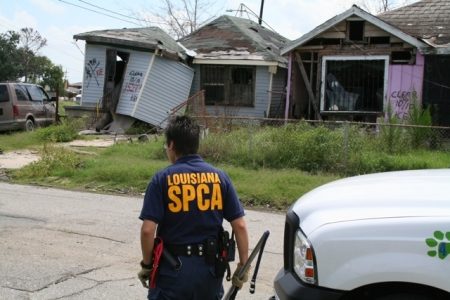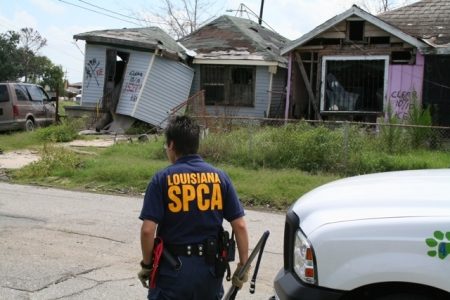

Rescuing frightened animals from disasters requires sharp handling skills
I witnessed the effects of disaster stress with my own eyes in New Orleans while I was part of a rescue team saving animals following hurricane Katrina. A rescued dog turned on one of us when we were outside of our temporary kenneling facility walking the animals. Without much warning, he bit off part of the man’s finger.
The animals we pulled off the streets were starving. They did attack people and other animals for food. But this dog had already been with us for a few days. He wasn’t hungry. As proof, he spit out the finger.
The discombobulated feelings humans have in the event of a disaster are intensified for animals, who are unable to communicate or question what’s happening. The frightening sights and smells of once-familiar surroundings cause stress, and that can lead to fear-based aggression.
“The fence that protects them is gone,” said Diane Webber, director of disaster preparedness and shelter management for Humane Society of United States (HSUS). “They have no boundaries. The familiar scents have been wiped away.”
Anne Culver, a disaster training consultant for HSUS’ emergency services, said “a lot of pets won’t do well if they’re separated from their owners.”
Webber and Culver were speaking to a group of Pacific Northwest rescuers at Disaster Response Animal Team (DART) training in Everett, Washington last week.
Webber warned that just like their human counterparts, unskilled working dogs tend to be a liability rather than an asset in a rescue situation.
“Only use working dogs to help you if you have the handler – they may not know what they’re doing,” Webber said.
Rescuers were taught diverse animal handling techniques, from rounding up spooked horses to careful handling of fearful iguanas, who might manifest stress by shredding your arm with their razor-sharp teeth. Rescuers learned that pillowcases are invaluable for reptile handling.
Rescuers were given tips on what to wear, and what to avoid wearing. Steel-toed boots, for example, can be dangerous when rounding up animals like horses and cows weighing in at more than 1,000 pounds. If stepped on, the steel in the shoes turn into razor blades that will slice your toes right off. Hip-waders are also frowned upon when rescuing animals from floodwaters. They fill up with water until they feel like cement shoes.
Besides slides, briefings and in-the-field stories from speakers, participants broke into small workshops to troubleshoot rescuing animals from mock disasters such as an apartment fire and a mudslide. The ever-changing circumstances required groups to update scenarios as the events unfolded, while organizing themselves under FEMA’s Incident Command System structure.
Join the newsletter and never miss out on dog content again!
"*" indicates required fields
By clicking the arrow, you agree to our web Terms of Use and Privacy & Cookie Policy. Easy unsubscribe links are provided in every email.